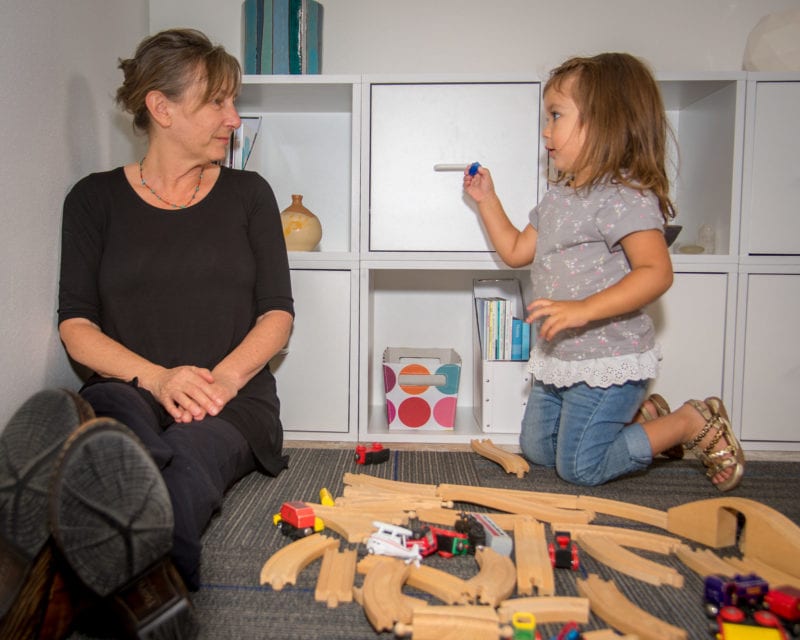
Helping Children Feel Safe
by Carol Castanon
Secure Beginnings Parent Consultant
June 2022 Update
Dear Families,
The article below was written at the beginning of the pandemic. There have been many variations of it, dating back to the initial piece written in the aftermath of Hurricane Katrina, 2005. Here we are today with the absolute tragic shooting of little children and teachers at Robb Elementary School.
During these last 17 years the way we receive news has changed in quantity, quality, and platform. We have been experiencing traumatic events in our backyards and in our back pockets. Our phone is always with us!
There is an edge to protecting children. It is from a privileged lens that we offer protection. But, there is also the real experience of children hearing or seeing images which they might be left to understand alone if we do not accompany them. This is for you, the parent or caregiver to know.
Questions on how we teach peace and collaborative problem solving are absolutely relevant to being human, especially with the very young. It is the foundation for resiliency and hope in the face of difficulty.
We are not alone!
—
Our world is both global and home based. We are walking a tightrope between the enormity of a pandemic and the intimacy of family and friends. One way to think about this moment is to simply think about protecting children when we can. We find ways to recover together, modeling empathy, and positive ways to cope and calm. At this time, we hope, it is within family that adults and children practice their capacity to be resilient in the face of difficulty. Below are some ideas for holding hard life experiences with empathy and endurance.
Reassurance – Let children know that you are there to take care of them and keep them safe. Children worry that something might happen to them. Point to the strategies you and other adults are creating to keep the family safe. This may be as simple as washing hands, or as strategic as social distancing. Parent and child proximity, being physically close, is very important to feeling safe. Even if your relationship does not have touching as part of your closeness, just by being near tells a child they are not alone. Calm voices, eye contact, smiles, and other warm gestures provide a blanket of security. This holds true for all ages. When adults have been upset, children need to hear the feeling vocabulary that matches this upset. They need to know that adults will take care of them and keep them safe to the very best of their ability. You might say, “I will take care of you even in sad, angry, and crying times.”
This is also an opportunity for role modeling healthy coping strategies. You might say, “I have had a hard day. Would you like to take a walk with me?” A teenager might say, “Yes, and can I listen to my music?” Perhaps their way of being close will shift with each step. This is a time to welcome the child you have! Make room for gentleness.
Observe, Listen and Reflect – Acknowledgement is important in all relationships. Observing and listening helps adults to get what children are thinking and feeling right. It is deeply comforting to children when caring adults listen to their thoughts, worries, longings, and fears. In crisis, these feelings may take a long time to reveal themselves, or these feelings may be part of dialogue together for many months ahead. Verbally reflect back to a child what you heard them say. Make sure you understand their perspective surrounding the event. Often, children have misunderstood, or are misinformed about the unfolding events. Is there misinformation within what they imagine, and what is real? Help children to sort and understand the details, appropriate to their stage of development.
Observe a child’s sleep, play and wakefulness. Is a child’s sleep agitated, or noticeably less, or too much? Play can be serious work when it is on the heels of a crisis. Play is the method children use to work out their inner world and experiences. Even a teenagers’ play may reflect a crisis. After 9/11, I witnessed teenage boys with access to blocks building towers. Observation is very helpful when a child is pre-verbal or not wanting to talk. Mr. Rogers, and his mother, talked about looking for the helpers when there is a crisis. Helpers might be doctors or firefighters, friends or family. Include this perspective in your dialogue or play with children. You might say, “Farmers are growing food, and mentors are helping teach all the children.” When play feels too scary, you might add, “Where are the doctors that help the people? Here come the doctors!”
Ritual and Structure – In the best of times, children need control or autonomy. This is why routine and predictability are important. Routine is how they know what was, what is now, and what comes next. Routine and control are intertwined. Even an older child can become less steady when routines become unpredictable. For the older child, if it’s not possible to have a clear plan beyond a day, talk about the plan for the present day. For the young child, “now and next” is enough. Daily routine can be broken down to the morning plan, the afternoon plan, and the evening plan. These plans must include who, what and where. This is reassuring for adults as well. As time allots, create increasingly predictable routines within the day. Tell children what is the same and what is different. Keep children informed as new plans emerge. For the pre-school child and up, when possible, make or use a calendar. The calendar can have who, what, and where, one day to one week at a time.
Rituals nourish the memory of important people. Lighting candles, saying prayers, making books, and making altars are all ways to honor people who are dear, or are in your family’s thoughts. You might say, “I have been thinking about all our friends and family. Let’s light a candle to honor them.” Mealtimes are often times of meaningful sharing, settling in toward relationship, and fully being present.
Understanding Behavior – Understanding behavior is important. Fear or sadness can look like anger. Regression with sleep or using the potty might feel overwhelming to parents or caregivers. Separation from Mom or Dad may become impossible. A simple visit to another room can trigger outbursts of cries. When adults look within behavior to understand its function, what the child is telling adults, it is more likely they can be responsive and not reactive. When parents or caregivers are responsive, it tells the child they are safe even when they are worried or sad. Adults accept the child’s range of emotion and accompany them along the way. Parents or caregivers might witness children appearing seemingly indifferent to events. You might witness denial or anger. Adults can be clear that it is acceptable to feel anger, sadness, or fear, but it is not ok to be hurtful or inflict pain on others. Adults are there to stop hurtful behavior and keep children safe. Adults can say exactly those words. Sometimes adults worry that any regression they see is permanent. Remember it is temporary, but it is an indicator that a child might have a hurt or worry. Adults may regress as well. Notice if your adult behavior surprises you. Sometimes a parent’s stress leads to reactions you thought had been learned and practiced away.
Releasing Tension and Calming Activities – If possible, adults settle with children without distraction or multi-tasking. Stanley Greenspan, M.D. called this Floor Time. Giving children of all ages your full presence, without any adult demands, is fulfilling, literally filling the emotional tank. Full attention, when possible, should be daily with several focused shorter times a day, or for one longer spacious period. Full and focused attention is one of the most important ways a parent or caregiver can show a loving calm, giving deep reassurance to children.
Children need a certain level of activity based on their nature and internal rhythms. The child, who is full of big body play, may need time running and climbing. Other children may seek a quieter time to read or draw together quietly. Sand, clay or playdough can be calming tactile materials. Some children love making lists of what is the same and what is different. Some children love making books about where and what the family is doing. Books may include the story of doctors, nurses and medicine. I have been calling these books “Now Books”, because they are simply the story of today. Sometimes, the future is unpredictable. If paper and pencil are not available, then telling the story is just as powerful. Telling the story helps children and adults put the informational and emotional pieces of experiences together. You might say, “Today is a home day. Oh dear, how do you feel about staying home? Are you missing your friends? When we are able to be with friends, you will be the first to know. It might take many more days.”
Make sure to include daily self-care routines. This might mean the child accompanying you at tea time! You are building a partnership which includes waiting, watching and wondering on your child’s part as well.
* Working parents and children are exploring how to both work and be in relationship. A child does not have the capacity to let their grown-up work all day with connection only during a lunch break. This is where a routine might be very helpful. Flexibility will be important as adults creatively find times to work during non-traditional work hours. Perhaps there is a long work stretch during a nap or quiet time, a movie, or a project. There will need to be anticipatory times of deep relating to fill a child, and this filling will need to be repeated throughout the day.
Media – The intention of the news is to be scary and seductive. Television and newspapers are too violent, negative, and vivid for children. If you need to have updated information, use print, the internet or radio might be more child friendly because it does not provide the graphic image. Sometimes, the TV becomes a source of passive attachment for children. You might say, “We have a new TV plan. TV is too scary. Let’s find different ways we can be together.”
The Helper Child – One way to nurture resilience is through meaningful work. This might be school work, or chores, or cooking a meal, tending the garden, making tea for an elder, flower arrangements, or feeding the pup. Notice what work your child values, and where they might feel good about contributing. Go towards their capacity to contribute. Each child is unique in their own way. To expand on helping, is to become a helper to others in the community or world. This might include letters of appreciation, donations, making face masks, research etc. It really depends on the age of a child, but all children can be helpers as well as acknowledging helpers. The helper paradigm nurtures resiliency!
Final Thoughts
All people experience a crisis or trauma at some point in the life of their family. It may be divorce, illness, or death. Sometimes financial crisis can have a devastating impact on the stability of family. Natural disasters, accidents, and violence may weave their way into family at one time or another. There is much to worry about. Children feel their parent or caregiver’s emotions. When adults include children, with an eye toward developmental readiness, the truth nurtures trust and resilience. Use the appropriate words for a crisis. In this case, naming Coronavirus is important so children don’t confuse other illnesses as holding the same danger. Children who have had to face difficulties can become more resilient. With support, a child’s endurance grows in the face of difficulty so they may continue to thrive and develop!



